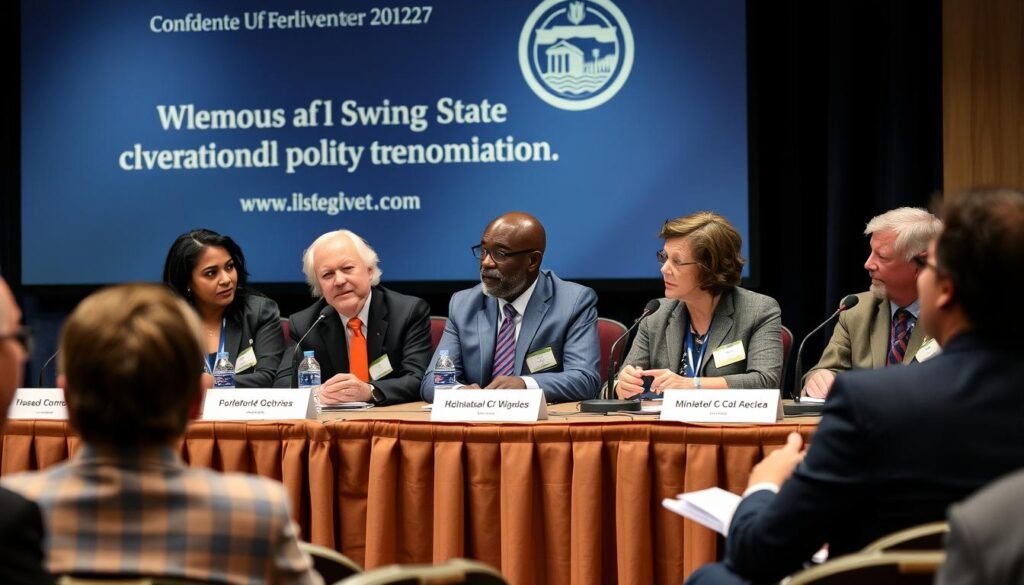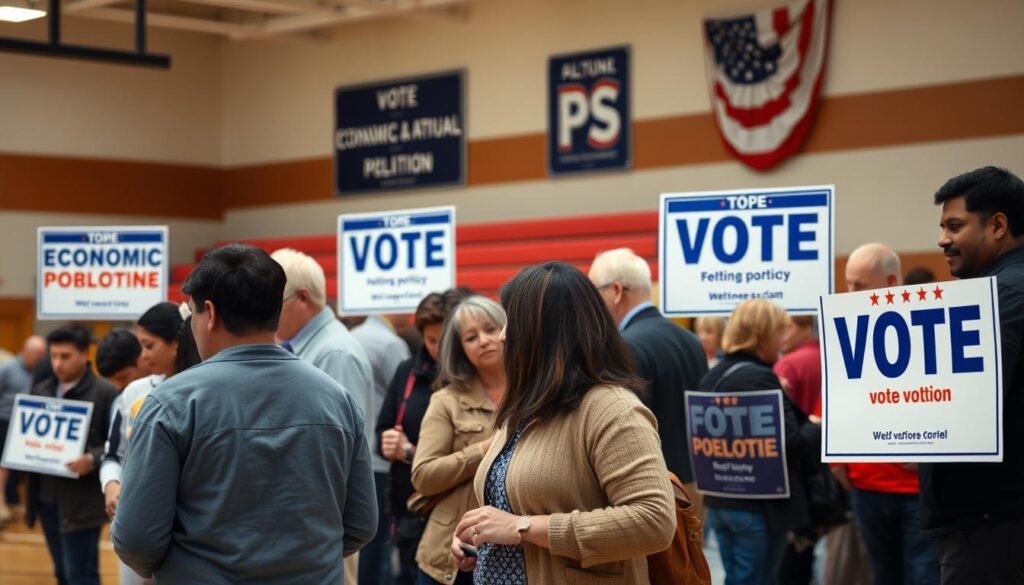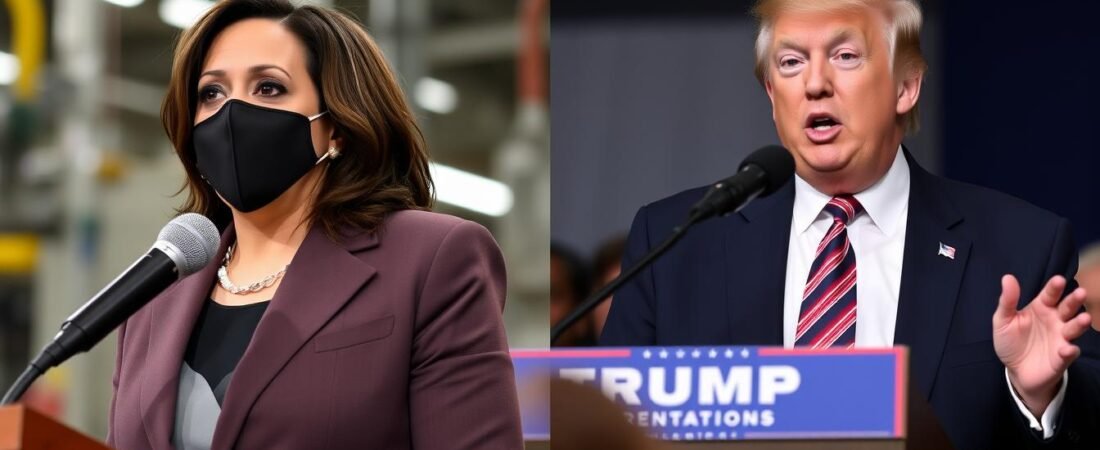In the high-stakes arena of presidential politics, swing states hold the keys to the White House. As the 2024 election approaches, economic promises have emerged as powerful tools that could determine which candidate captures these crucial battlegrounds. From Pennsylvania’s manufacturing heartland to Arizona’s border communities, voters are weighing competing visions for America’s economic future against their own financial realities.
With inflation concerns lingering and cost-of-living pressures mounting, candidates’ economic pledges are under intense scrutiny from voters who have grown skeptical of Washington’s ability to deliver meaningful change. This analysis explores how economic promises are resonating across the seven key swing states that will likely decide the next president.
The Swing State Landscape: Economic Battlegrounds
The 2024 election hinges on seven critical swing states: Pennsylvania, Michigan, Wisconsin, Georgia, Arizona, Nevada, and North Carolina. Each state presents a unique economic profile with distinct voter concerns that candidates must address to secure victory.
These states represent 93 electoral votes – more than enough to tip the balance in a close election. Recent polling shows economic issues consistently ranking as the top concern for voters across these battlegrounds, with inflation, jobs, and housing costs dominating kitchen-table conversations.
Stay Informed on Swing State Developments
Receive our weekly newsletter with the latest economic data, policy proposals, and analysis focused on the seven states that will decide the election.
Economic Priorities: What Swing State Voters Want
Across the swing states, voters share common economic concerns while also prioritizing region-specific issues. Understanding these priorities is crucial for candidates crafting economic messages that resonate.
Inflation & Cost of Living
Consistently ranked as the top economic concern, with 53% of swing state voters citing inflation as their primary economic worry. Food prices and housing costs are the most frequently mentioned pain points.
Jobs & Manufacturing
Particularly important in Pennsylvania, Michigan, and Wisconsin, where voters express concern about industrial decline and outsourcing. Manufacturing promises resonate strongly in these states.
Housing Affordability
A dominant issue in Nevada and Arizona, where rapid population growth has driven housing costs upward. Voters in these states are seeking solutions to the affordable housing crisis.
Regional priorities also play a significant role. In Georgia, healthcare costs rank higher than the national average as a concern. Arizona voters place greater emphasis on border security’s economic impacts, while North Carolina voters frequently mention education funding as an economic priority.
Competing Economic Visions: The Promises on the Table
The economic proposals from both major candidates offer stark contrasts in approach, tax policy, and spending priorities. These differences are particularly significant for swing state voters weighing their options.
Harris Economic Proposals
- Expand Medicare coverage to include vision, dental, and hearing
- Raise taxes on the wealthy (28% corporate tax rate)
- Increase protections for abortion rights
- Raise minimum wage to $15 per hour
- Federal ban on price gouging for food and groceries
- Tax cuts for “more than 100 million working and middle-class Americans”
Trump Economic Proposals
- Cut corporate tax rate to 15%
- Significantly increase Child Tax Credit
- “End inflation” through government spending cuts
- Increase oil drilling and energy production
- Tariffs on imported goods
- Automatic green cards for foreign graduates of US universities
Economic experts remain divided on which approach would better serve swing state economies. “The fundamental question for voters is whether they believe top-down or bottom-up economic policies will improve their financial situation,” notes economist Claudia Sahm, former Federal Reserve economist.
Harris and Trump presenting their economic visions at recent campaign events
Potential Benefits of Harris Plan
- Expanded healthcare coverage for seniors
- Direct consumer protection from price gouging
- Wage growth for lower-income workers
- Progressive tax structure
Potential Drawbacks of Harris Plan
- Higher corporate taxes could affect business investment
- Price controls may create market distortions
- Implementation challenges for new regulations
- Potential impact on deficit
Potential Benefits of Trump Plan
- Lower corporate taxes could boost business investment
- Increased domestic energy production
- Enhanced Child Tax Credit for families
- Talent retention through immigration incentives
Potential Drawbacks of Trump Plan
- Tariffs may increase consumer prices
- Tax cuts could expand federal deficit
- Uncertain impact on inflation
- Environmental concerns from expanded drilling
State-by-State: How Economic Promises Could Impact Key Battlegrounds
Each swing state has unique economic characteristics that make certain economic promises particularly resonant with local voters. Understanding these state-specific dynamics is crucial for predicting how economic messaging will influence the election outcome.
Pennsylvania: Manufacturing and Energy
With 19 electoral votes, Pennsylvania is the largest prize among swing states. The state’s economy features a mix of manufacturing, energy production, and service industries. Trump’s promises on energy deregulation and tariffs appeal to the state’s coal and natural gas workers, while Harris’s manufacturing initiatives target the state’s industrial workforce.
“Pennsylvania voters are particularly sensitive to energy policy promises,” explains Terry Madonna, Senior Fellow at Millersville University. “The fracking debate directly impacts thousands of jobs across the state, making it a key economic battleground.”

Manufacturing remains a crucial sector in Pennsylvania’s economy
Michigan: Auto Industry and Trade
Michigan’s 15 electoral votes are heavily influenced by the auto industry’s fortunes. Harris’s support for electric vehicle manufacturing incentives appeals to the state’s evolving auto sector, while Trump’s promises on trade renegotiation resonate with workers concerned about outsourcing.
Recent polling shows Michigan voters split on which candidate would better serve the state’s economic interests, with 34% favoring Trump’s approach and 28% preferring Harris’s vision.
Arizona: Border Economy and Housing
Arizona’s 11 electoral votes are influenced by border economics and a housing affordability crisis. Trump’s border security proposals have economic dimensions that appeal to voters concerned about immigration’s fiscal impact, while Harris’s housing affordability measures address the state’s soaring real estate costs.
Download Our Economic Policy Comparison Guide
Get our detailed analysis of how each candidate’s economic proposals would impact each swing state, with expert commentary and data visualizations.
Historical Context: Economic Promises and Swing State Outcomes
Economic promises have historically played a decisive role in swing state outcomes. Examining past elections provides valuable context for understanding how current economic pledges might influence the 2024 results.
Reagan’s tax cuts in the 1980s helped secure crucial Rust Belt states that were traditionally Democratic. Bill Clinton’s economic messaging on the “middle class squeeze” in 1992 helped flip several Bush states. More recently, Trump’s 2016 promises on trade and manufacturing resonated strongly in Pennsylvania, Michigan, and Wisconsin – states that had voted Democratic for decades.
“Economic promises matter most when voters feel economic pain,” explains political historian Julian Zelizer of Princeton University. “In 2024, with inflation concerns still lingering, economic credibility will be a crucial factor in swing states.”
| Election Year | Key Economic Promise | Swing States Won | Electoral Impact |
| 1992 | Clinton’s “It’s the economy, stupid” | PA, MI, WI, GA | Decisive victory |
| 2000 | Bush tax cuts | FL, OH | Narrow victory |
| 2008 | Obama’s recovery plan | FL, OH, NC, VA | Decisive victory |
| 2016 | Trump’s trade/manufacturing focus | PA, MI, WI | Narrow victory |
| 2020 | Biden’s pandemic recovery | PA, MI, WI, GA, AZ | Decisive victory |
Voter Perspectives: Economic Promises Through the Swing State Lens
To understand how economic promises are resonating, we must examine the perspectives of swing state voters themselves. Polling and interviews reveal nuanced views that transcend simple partisan divisions.

Swing state voters discussing economic concerns at a community forum in Wisconsin
In focus groups conducted across swing states, voters consistently express skepticism about grand economic promises from either candidate. “I’ve heard big talk before,” says Michael Reeves, a manufacturing worker from Erie, Pennsylvania. “What matters is whether these plans will actually help people like me afford healthcare and put my kids through college.”
This skepticism is reflected in polling data showing that while economic issues dominate voter concerns, trust in either candidate’s ability to deliver economic improvements remains relatively low. Only 34% of swing state voters believe Trump would improve their personal financial situation, while 28% believe Harris would do so.
“Voters in these states aren’t looking for economic revolution – they want stability, affordability, and opportunity. The candidate who can credibly promise those things has a significant advantage.”
Demographic differences also emerge in how economic promises are received. Working-class voters without college degrees tend to respond more positively to Trump’s manufacturing and trade promises, while suburban voters with higher education levels often find Harris’s healthcare and childcare proposals more appealing.
Expert Analysis: Will Economic Promises Deliver Votes?
Political analysts and economists offer varying perspectives on how economic promises will influence the outcome in swing states. Their insights provide valuable context for understanding the electoral implications.
The Inflation Factor
“Despite improvements, inflation remains the dominant economic concern for swing state voters. The candidate who can credibly promise price stability has a significant advantage.” — Jason Furman, former Chair of the Council of Economic Advisers
Manufacturing Revival
“Manufacturing promises resonate strongly in Pennsylvania, Michigan, and Wisconsin. These states have experienced decades of industrial decline, making manufacturing policy a potential vote-winner.” — Shannon O’Neil, Council on Foreign Relations
Housing Affordability
“In fast-growing states like Arizona and Nevada, housing affordability has become a kitchen-table issue. Economic proposals that address this crisis could swing these states.” — Jenny Schuetz, Brookings Institution
Economic credibility remains a crucial factor. Voters are evaluating not just the promises themselves, but whether they believe candidates can actually deliver on them. This credibility gap presents both challenges and opportunities for the campaigns.

Economic policy experts discussing swing state dynamics at a recent forum
“The economic promises that matter most are those that address voters’ immediate concerns,” explains political strategist David Axelrod. “In 2024, that means addressing inflation, housing costs, and economic security. The candidate who connects their policies to these kitchen-table issues will have an advantage in swing states.”
State-Specific Economic Strategies
Both campaigns are tailoring their economic messages to address state-specific concerns, recognizing that a one-size-fits-all approach is insufficient for the diverse swing state landscape.
Georgia: Healthcare Economy
In Georgia, healthcare costs rank higher than the national average as a concern. Harris has emphasized her Medicare expansion proposals during Georgia visits, while Trump has focused on his plans to reduce prescription drug prices through international price matching.
Wisconsin: Dairy and Manufacturing
Wisconsin’s dairy industry and manufacturing sector make trade policy particularly important. Both candidates have tailored their economic messages to address agricultural exports and industrial competitiveness when campaigning in the state.
Nevada: Tourism and Housing
Nevada’s tourism-dependent economy and housing affordability crisis create unique economic concerns. Harris has highlighted her anti-price gouging proposals when discussing housing, while Trump has emphasized how his immigration policies would affect Nevada’s labor market and housing demand.
Key Insight: The most effective economic promises are those that address state-specific concerns while connecting to broader national themes. Generic economic messaging is less effective in swing states than targeted proposals that acknowledge local economic conditions.
Frequently Asked Questions: Swing States and Economic Promises
How do economic promises typically influence swing state voters?
Economic promises tend to have the greatest impact when they address voters’ immediate financial concerns. In 2024, this means addressing inflation, housing affordability, and job security. Historically, swing state voters have responded most strongly to economic messages that connect national policies to local economic conditions and personal financial situations.
Which economic issues matter most in Pennsylvania?
Pennsylvania voters consistently rank manufacturing jobs, energy policy (particularly regarding fracking), and healthcare costs as their top economic concerns. The state’s mix of industrial, energy, and agricultural sectors means that trade policy, energy regulations, and manufacturing initiatives receive particular attention from voters.
How do Harris and Trump differ on manufacturing policy?
Harris supports manufacturing growth through targeted tax incentives for domestic production, workforce development programs, and clean energy manufacturing initiatives. Trump emphasizes tariffs on imported goods, deregulation, and corporate tax cuts as his primary manufacturing strategy. Both claim their approach will create more manufacturing jobs in swing states.
Which candidate’s economic plan would better address inflation?
Economists are divided on this question. Some argue that Trump’s focus on energy production and deregulation could reduce certain costs, while others suggest Harris’s anti-price gouging measures and targeted tax relief could be more effective. The impact would likely vary by state and economic sector, with neither plan offering a comprehensive solution to inflation’s complex causes.
How important are economic promises compared to other issues in swing states?
Polling consistently shows economic issues ranking as the top concern for swing state voters, with 37% citing “the economy, jobs, and inflation” as their most important issue. However, other issues like abortion rights, immigration, and healthcare also influence voting decisions. The relative importance of economic promises varies by demographic group and individual state circumstances.
Conclusion: Economic Promises and the Path to Victory
As the 2024 election approaches, economic promises will continue to play a central role in determining which candidate captures the crucial swing states. The effectiveness of these promises will depend not just on their substance, but on how credibly candidates can connect them to voters’ everyday financial concerns.
In Pennsylvania, Michigan, and Wisconsin, manufacturing and trade policies will likely prove decisive. In Arizona and Nevada, addressing housing affordability and border economics could determine the outcome. Georgia and North Carolina voters will weigh healthcare costs and educational economic opportunities alongside broader economic concerns.

Voters considering economic factors as they head to the polls
The candidate who can craft economic promises that resonate with state-specific concerns while maintaining credibility on national economic issues will have a significant advantage in November. As history has shown, in close elections, economic messaging that connects with swing state voters can make the difference between victory and defeat.
Stay Informed Through Election Day
Subscribe to our newsletter for weekly updates on economic proposals, swing state polling, and expert analysis as the election approaches.
